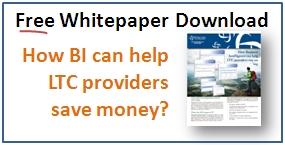 Data mining represents wealth, a wealth of opportunity, action, and success. Directly put, data mining (the process of centralized data management and retrieval) helps LTC providers find hidden treasures of knowledge, not just data. Just as rare gems or precious minerals are only valuable when processed from the ore that is unearthed, so too is knowledge when refined from countless bytes of data. Refined data transformed into information becomes knowledge and knowledge – the power to act. Data mining, therefore, helps executives discover what is happening now, track trends, anticipate with some accuracy what may happen in the future, and explore the strengths of possible actions.
Data mining represents wealth, a wealth of opportunity, action, and success. Directly put, data mining (the process of centralized data management and retrieval) helps LTC providers find hidden treasures of knowledge, not just data. Just as rare gems or precious minerals are only valuable when processed from the ore that is unearthed, so too is knowledge when refined from countless bytes of data. Refined data transformed into information becomes knowledge and knowledge – the power to act. Data mining, therefore, helps executives discover what is happening now, track trends, anticipate with some accuracy what may happen in the future, and explore the strengths of possible actions.
In real terms, providers today have the ability to mine their own data and, yes, to share the data and knowledge with others at practically a simple click of a button. They can view and act on Key Performance Indicators (KPIs) in real-time* and, based on the information collected, take action or create their own predictive models or what-if scenarios. Some vital KPIs, among others, include:
- Census Information, such as actual-to-budget census by payer type
- Admissions and Discharges trending, including admissions sources and discharge destinations, lengths of stay, and readmissions to hospitals
- Labor information, including actual-to-budget as well as actual-to-flex budget (by which providers can determine staffing needs based on the actual census)
- A review of overtime hours so that providers can schedule staff and minimize overtime pay
- Cash and accounts receivable comparing actual payments to targeted collection dates by payer, also cash trending by payer, reconciliation of collections to bank statements, DSO, periodic aging reports
- Regulatory reporting, such as the 671 report, detailed discharge reports, reports for uploading to other systems, such as AHCA’s Trend Tracker
- Clinical SNF and assisted living KPIs, including relevant trending
The strength of data mining for operators of multiple facilities lies in its ability to drill down from a consolidated dashboard view configured by the provider to the region, facility, department, individual employee, or resident. Administration of such a system is provider driven to determine who shall have access to what within the system.
A viable data mining system is responsive to the ever-changing long term care environment, such as data and information-hungry ACOs, remaining top of mind for hospital discharge planners by maintaining hospital readmissions at an acceptable level, involvement in policy-determining studies, or meeting HIT requirements (Stage 2 meaningful use) to be eligible for the federal electronic health-record financial incentive program.
Data mining is more than a curiosity; it is the Mother Lode of vital information in today’s health care environment. Talk to us during the AHCA/NCAL 63rd Annual Convention and Expo, booth #1317, or during the 2012 LeadingAge Annual Meeting and Exposition, booth #530,to discover for yourself how providers like you have benefited in real dollars from data mining using our primeVIEW business intelligence tool.
*Let’s talk about “real-time” for a moment. The term, real-time, can mean “without perceivable delay.” So, in this case, the data is processed as soon as it is received. How often is the data pulled? That is directly driven by the provider’s need to know. You could say that “real-time” reporting is driven by the need for “real-time” decision making. For example, labor hours require perhaps a greater frequency of reporting during a given day than collections or census. Our primeVIEW customers determine data pull frequency.
/Prime-Care-Technologies-Logo.png?width=191&height=55&name=Prime-Care-Technologies-Logo.png)

 Data mining represents wealth, a wealth of opportunity, action, and success. Directly put, data mining (the process of centralized data management and retrieval) helps LTC providers find hidden treasures of knowledge, not just data. Just as rare gems or precious minerals are only valuable when processed from the ore that is unearthed, so too is knowledge when refined from countless bytes of data. Refined data transformed into information becomes knowledge and knowledge – the power to act. Data mining, therefore, helps executives discover what is happening now, track trends, anticipate with some accuracy what may happen in the future, and explore the strengths of possible actions.
Data mining represents wealth, a wealth of opportunity, action, and success. Directly put, data mining (the process of centralized data management and retrieval) helps LTC providers find hidden treasures of knowledge, not just data. Just as rare gems or precious minerals are only valuable when processed from the ore that is unearthed, so too is knowledge when refined from countless bytes of data. Refined data transformed into information becomes knowledge and knowledge – the power to act. Data mining, therefore, helps executives discover what is happening now, track trends, anticipate with some accuracy what may happen in the future, and explore the strengths of possible actions.
